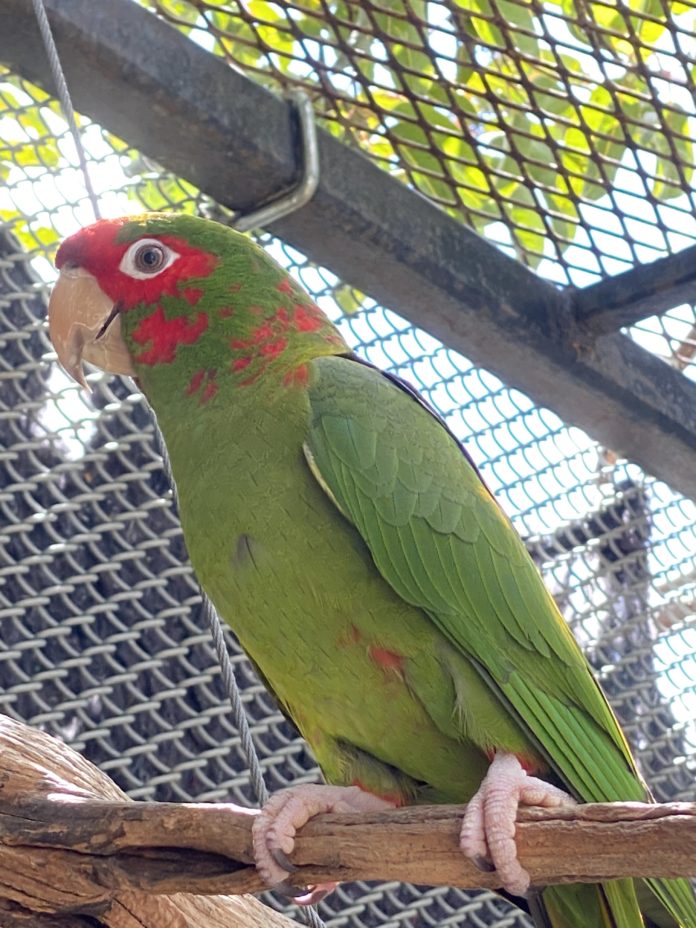Parrot Talk
Every so often, or if you live in some parts of San Diego, you will hear loud squawking. If you look up, you will see a hoard of different kinds of parrots. To shed light on what they are, why they are here, and what their future might be, Sarah Mansfield of SoCal Parrot spoke to the Mission Hills Garden Club in June.

SoCal Parrot’s mission states that it “Was founded to bridge the gap of care and consideration for wild, naturalized parrots and to be a resource for wild parrot rehabilitation, education and protection.” This may involve rescuing wild parrots, doing what is needed to heal injured or sick birds, releasing them if and when they can survive in the wild, educating the public about these parrots, and creating protection for these birds through public awareness by working with local communities.
Many of these parrot species are endangered. For example, in its native eastern Mexico, there are fewer than 1,000 Red-Crowned Amazon, yet there are over 1,500 living in Southern California. Also endangered and found in the same neighborhoods as the Red-Crowned is the Lilac-Crowned Amazon from western Mexico. The Yellow-Headed Amazon is critically endangered; it came from Southeast Mexico and Central America, and now we have only three birds or fewer in Imperial Beach. They can be found in Los Angeles as well. These Yellow-Headed Amazon parrots are endangeredC as they are extremely desirable for the pet trade.
Of the parakeets, the Mitred Conure is found throughout Southern California and hales from Peru, Bolivia, and Argentina. His population is stable in his homeland. From Ecuador and Peru, we have the Cherry-Headed Conure. Considered vulnerable and featured in the film, “The Wild Parrots of Telegraph Hill.” The Blue-Crowned Conure likes Ocean Beach and Point Loma. His population is stable in Brazil Argentina, Venezuela, Bolivia and Colombia.
The wild parrots of San Diego came via various ways, mostly nefarious. Until recently, wild parrots could be legally sold in the United States. However, wild parrots are primarily native to Mexico, Central and South America, Asia, and Africa. They did not migrate to the United States although they are also found in Texas and Florida as well as Southern California. All our San Diego parrots either were born in their native land and brought by humans to the States or are descended from these birds. They did not migrate.
Prior to 1992, it was perfectly legal to buy wild-caught parrots. Still, many of these birds were smuggled over the border. I remember a story I heard in the 70s about a man who used to smuggle birds in his pant legs! Needless to say, not all these birds survive. The lucky ones escape. Others used to be sold to pet stores who sold them as pets. Sometimes pet birds escape and have to find shelter. To survive, they find other non-native species.
Parrots mate for life. Some find mates and have babies, some die, yet others survive. Some of the survivors fall from the nest and may need to be rescued.
Sarah explained, “Amazons have one to three offspring annually. We rescue babies and juveniles, anywhere from 40 to 670 during the amazon ’baby season.’”
Each year the society raises from one to three of these rescued. Once weaned and capable of flight, they are released, often near the flock from where they came. Babies are released in September and October. To ease their re-entry to the parrot society, Sarah continued, ”We release the younger ones as a “mini flock” at dusk, in the same spot where the parrots roost. That way, when everyone wakes up in the morning, they can fly off together to forage and socialize.”
San Diego County parrots range from Ocean Beach and Shelter Island to Oceanside and as far east as Ramona. The Amazons tend to flock together: Red and Lilac-Crowned and an occasional Yellow-Headed Amazon. Smaller than the Amazons are the parakeets known as Conures – Mitred, Red-Masked, and Blue-Crowned. The birds stay in the same neighborhoods, but they flock with their own species. They like to make their homes in ornamental trees such as magnolias, loquats pines, eucalyptus, coral trees and pecans, which provide both room and board. Sadly, their native habitats are rapidly disappearing. Fortunately, they manage to survive in our warmer-climate cities. In Southern California at least 13 non-native parrot species have been identified, some of which are endangered.
The first meeting of the new membership year will be September 24 from 6 to 8 p.m. Unless there are big changes between now and then (I am writing in mid July), the meeting will be via Zoom. You will receive an email with directions how to enter this virtual meeting.
Category: Animals, feature, Local News, Nonprofit







